 Technology peripherals
Technology peripherals
 AI
AI
 APUS Li Tao: Customize large models for China to let AI create more value
APUS Li Tao: Customize large models for China to let AI create more value
APUS Li Tao: Customize large models for China to let AI create more value
On October 24, the 3rd China (Ningbo) Software Summit and Programmers Festival was held. Ni Guangnan, academician of the Chinese Academy of Engineering, Shen Changxiang, academician of the Chinese Academy of Engineering, and many corporate celebrities gathered on site to discuss the development of the software industry. . Li Tao, Chairman and CEO of APUS, a domestic AI large model company, focused on the theme of "AI leads the future with new intelligence" at this summit, analyzing how large models can lead industrial change, create value and promote social progress, and creatively proposed the AI Big Model The “six elements” view of model value creation.
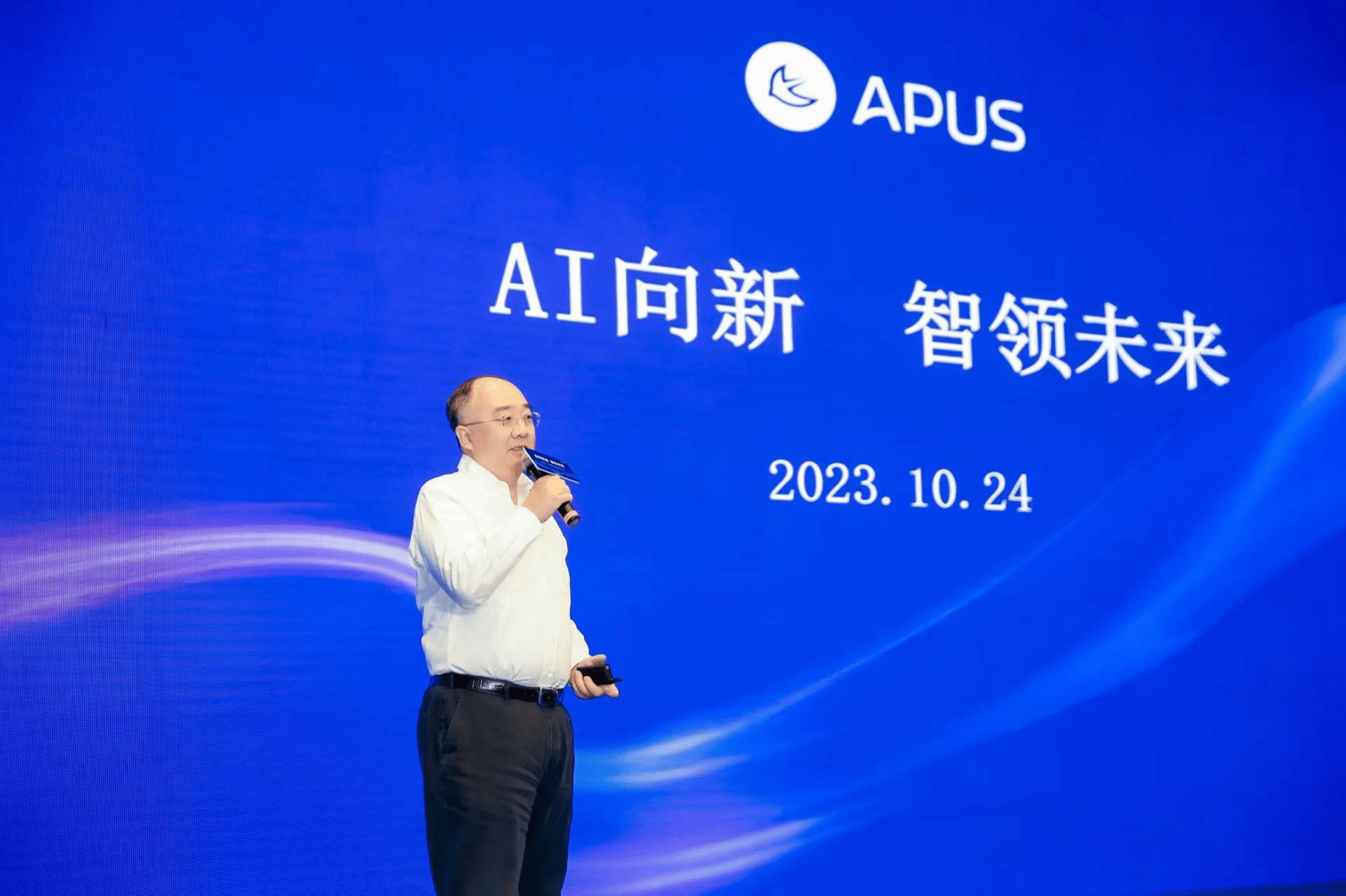
(APUS Li Tao speaks on the spot)
AI large model brings comprehensive changes
Artificial intelligence large model technology has developed rapidly and is gradually being implemented in various scenarios and creating rich application value. It has become an important driving force in promoting industrial upgrading and an important force in changing society.
Li Tao proposed that under the trend of AI reconstructing the industry, large models play the role of the underlying "operating system" to integrate, schedule, and allocate resources such as computing power, data, and applications, and comprehensively promote the construction of industrial networks. For example:
In the field of industrial Internet, multi-modal large model capabilities can monitor and analyze production line data in real time, provide support such as predictive maintenance, quality control and production optimization, and improve the efficiency and quality of industrial manufacturing;
In the field of agricultural Internet, the multi-modal large model restarts the construction of agricultural digital networks, uses AI to enhance the intelligence level of the entire chain of "production, supply, marketing, and service management", and promotes innovative applications such as digital machinery and digital live broadcast to improve production and sales efficiency;
In the field of the Internet of Things, the multi-modal capabilities of intelligent hardware and large models are connected, enabling them to independently possess perception and cognition, providing comprehensive, efficient and reliable guidance for innovative research and development;
On the journey of exploring the metaverse, the powerful reasoning capabilities of large models help the metaverse build cognition, supporting the rapid generation of exquisite design, complex modeling, human-computer interaction, mechanism establishment, and space operation and maintenance in space, allowing the metaverse to be quickly generated. The concept of the universe becomes possible.
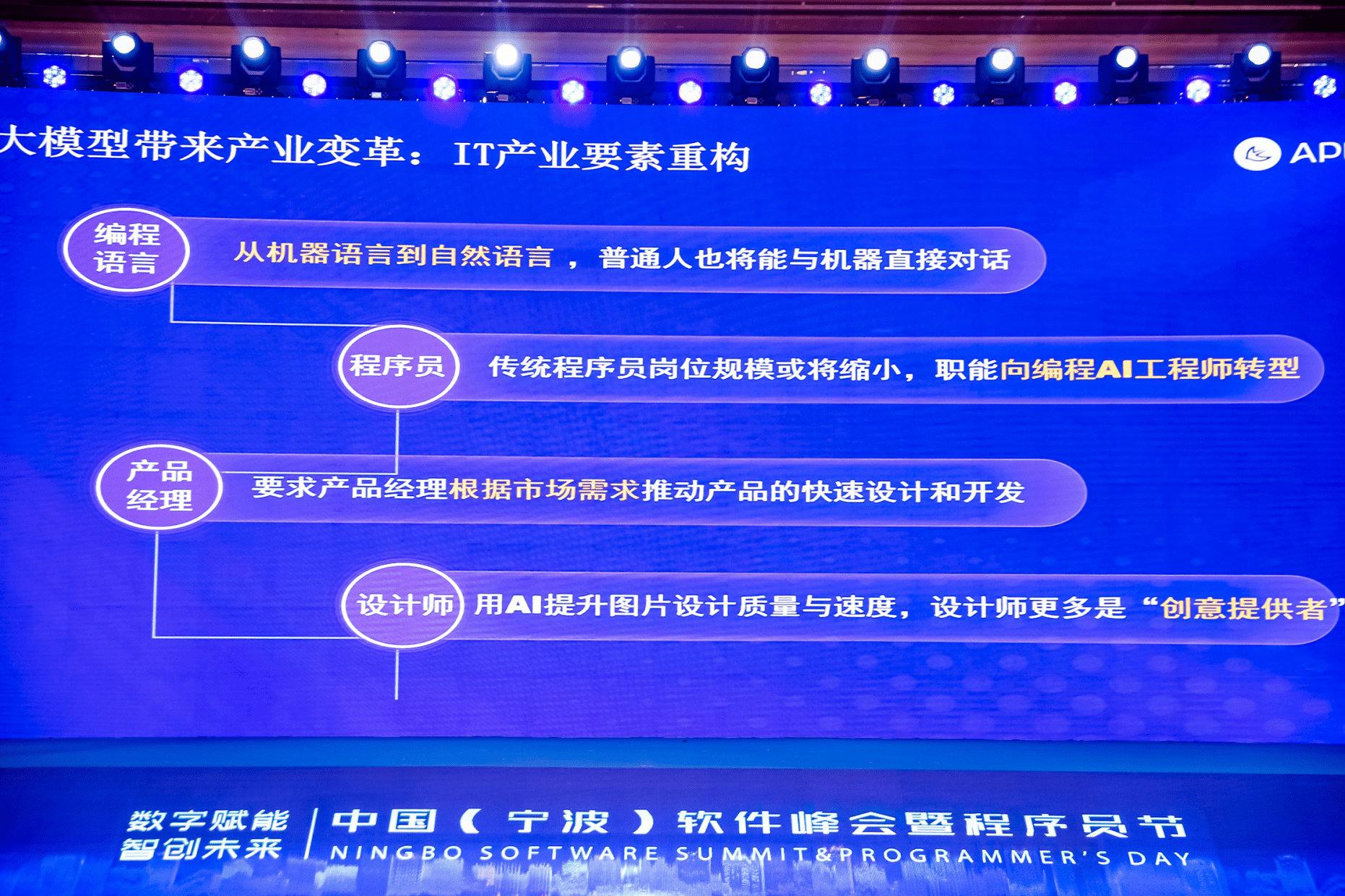
(AI changes industrial factors)
Using large models as the driving force not only brings about changes in the Internet industry, but also brings about iterative upgrades of IT elements. Li Tao believes that with the popularization of AI, natural language will be widely used in programming in the future, and people can talk directly to machines; at the same time, functional positions such as programmers, product managers, and designers will also transform into "designers" of needs. By handing over tedious, mechanical, and repetitive work to large models and handing over value-creating work to people, social resource allocation will be more reasonable.
Building China’s large model competitiveness
Whether it is oriented to industry or IT elements, AI large models demonstrate powerful reconstruction capabilities. "Although large models seem to be 'omnipotent', not all models can be verified in practice, and not all models can create real value." Li Tao said. He believes that the goal of the development of large AI models is value creation, and to achieve value creation, "six elements" must be present: strong computing power, global knowledge base, high-quality data, continuously evolving algorithms, value alignment, and scenario integration value creation .
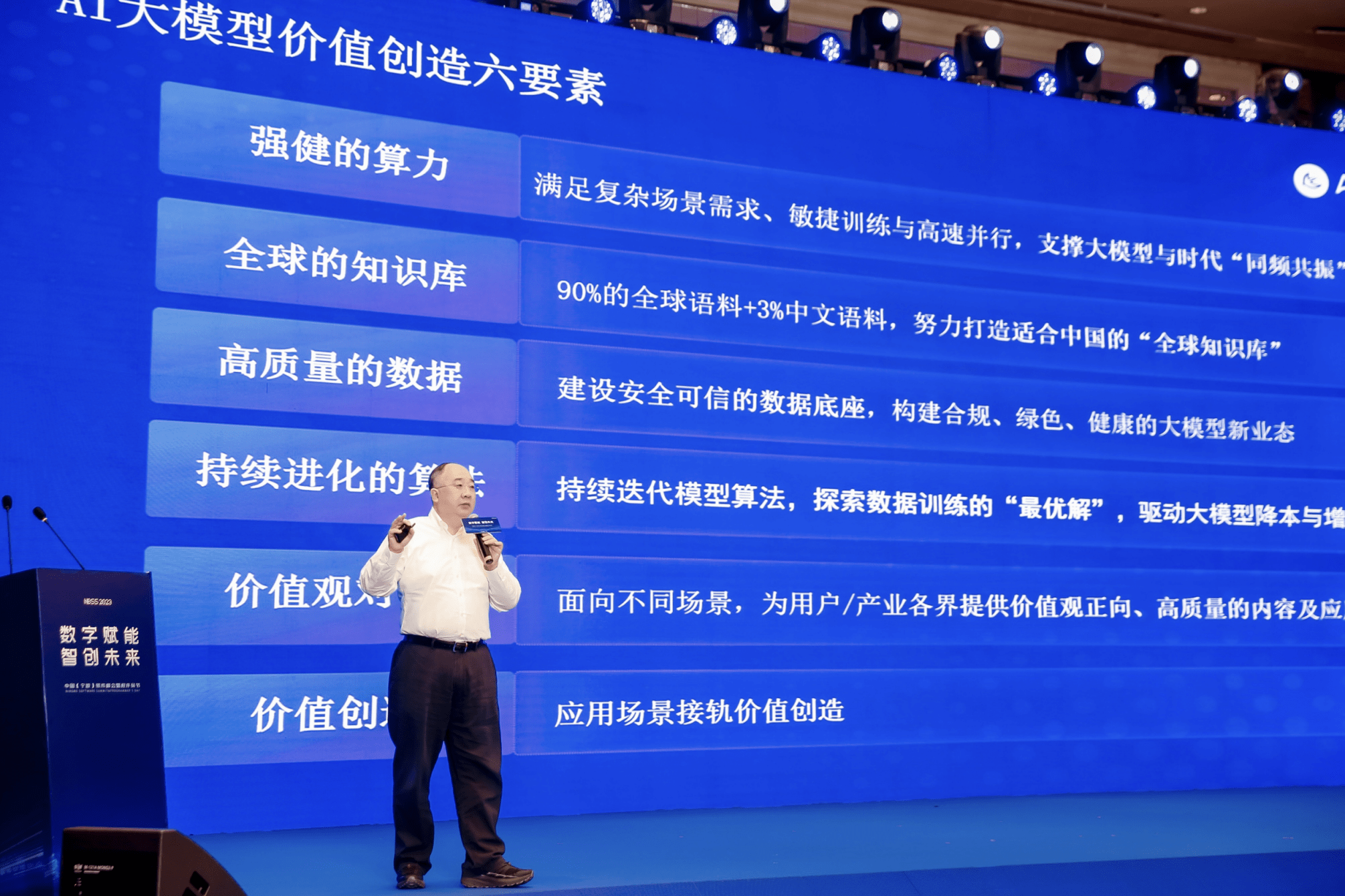
(Six elements of AI large model value creation)
Compared with leading foreign large models, China's large model industry started late, and technical bottlenecks such as algorithm computing power are difficult to break through in a short time; and due to limitations of Chinese corpus data, there is little high-quality data for training large models, and China's Big models aren’t “smart enough” yet. "Chinese corpus accounts for only 3% of the global knowledge base. Breaking through the data bottleneck is also a difficult problem that China's large model manufacturers must unite to tackle." Li Tao said.
Although some models seem to be "smart enough", there are problems such as misaligned values. In this regard, APUS believes that China's AI application research and development must still be based on China's large models. Therefore, China's large model manufacturers must have a sense of independence and shoulder the responsibility of independent innovation; build differentiated barriers based on the needs of the Chinese market and create accurate products that meet China's needs and values. AI large model to create new AI productivity.
Connect applications with value creation
The current large model market is still in the exploratory period of commercial implementation. It has long been an industry consensus that large models can create good AI applications and serve market needs well. Li Tao pointed out: "China's digital construction is a continuous iterative process, which requires a large model 'base' to support the rapid transformation of intelligent scenarios. Facing complex needs, APUS will continue to customize large AI models for the Chinese market to integrate AI applications with value creation. ”
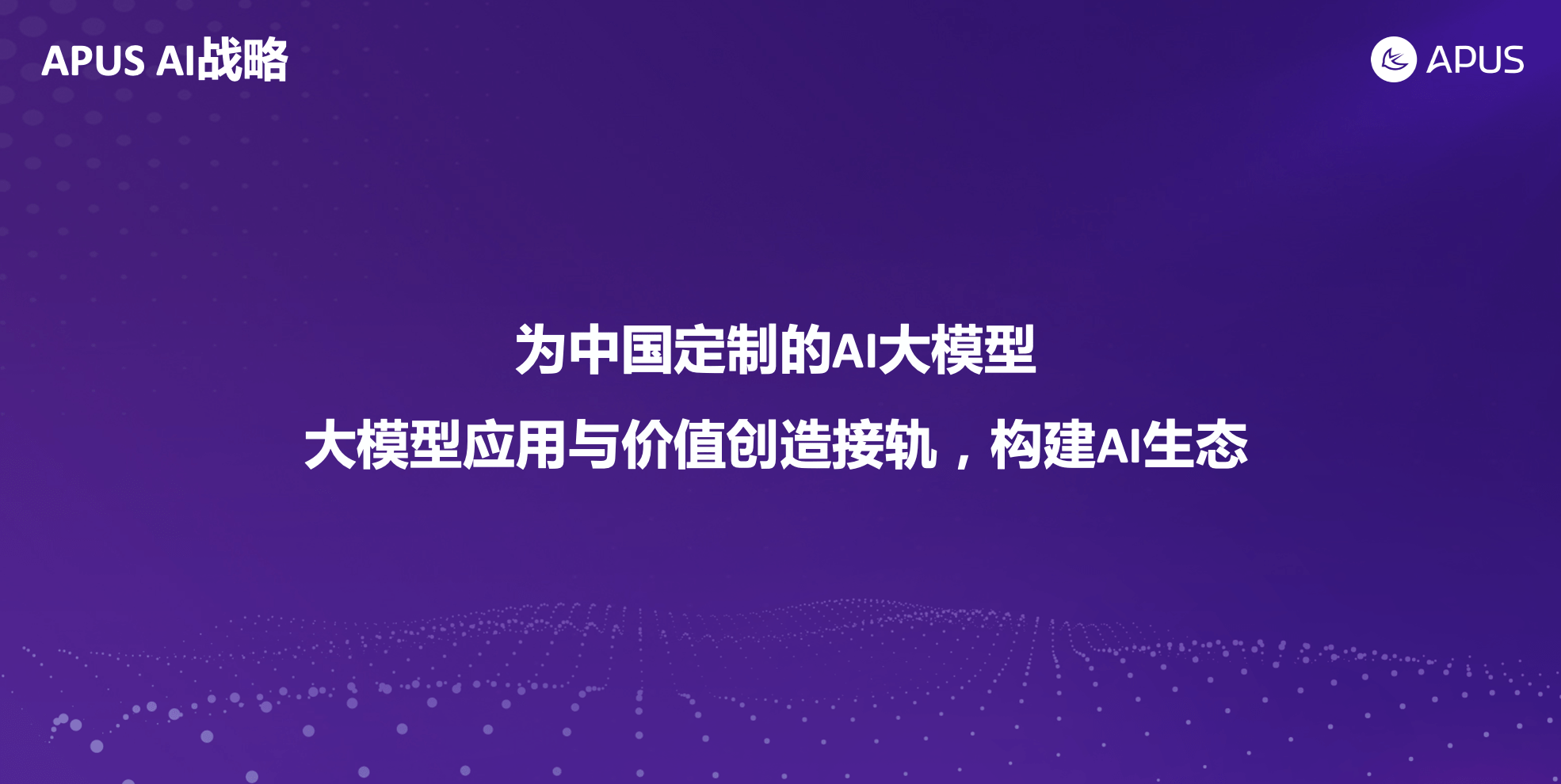
(APUS’s AI strategy)
In terms of data, APUS has formed unique global user data and high-quality corpus based on the past 9 years of global business and 2.4 billion global users; at the same time, APUS cooperates with domestic corpus manufacturers to jointly build a database for the Chinese market. The “red corpus” of positive values. In terms of computing power, APUS has invested in the construction of two major intelligent computing centers around the world, and has linked up with cloud computing manufacturers such as Alibaba, Baidu, and Tencent to provide demanders with a variety of computing power combinations and elastic expansion solutions, helping enterprises and developers to achieve rapid implementation of research and development. , Costs are significantly reduced.

(AI large model built for China)
At present, APUS has cooperated with multiple industry partners such as medical, network information, manufacturing, and e-commerce to jointly create large-scale industry solutions, using AI to help partners upgrade their hardware infrastructure, build basic model platforms, and implement specific Business application innovation.
At the same time, APUS also continues to open up its ecosystem and cooperates deeply with manufacturers such as Baidu, Tencent Cloud, and Alibaba Cloud to build flexible industrial collaboration. For example, the APUS large model has opened model plug-ins, and developers can independently access external models and solve complex scene requirements through the capabilities of "model groups".
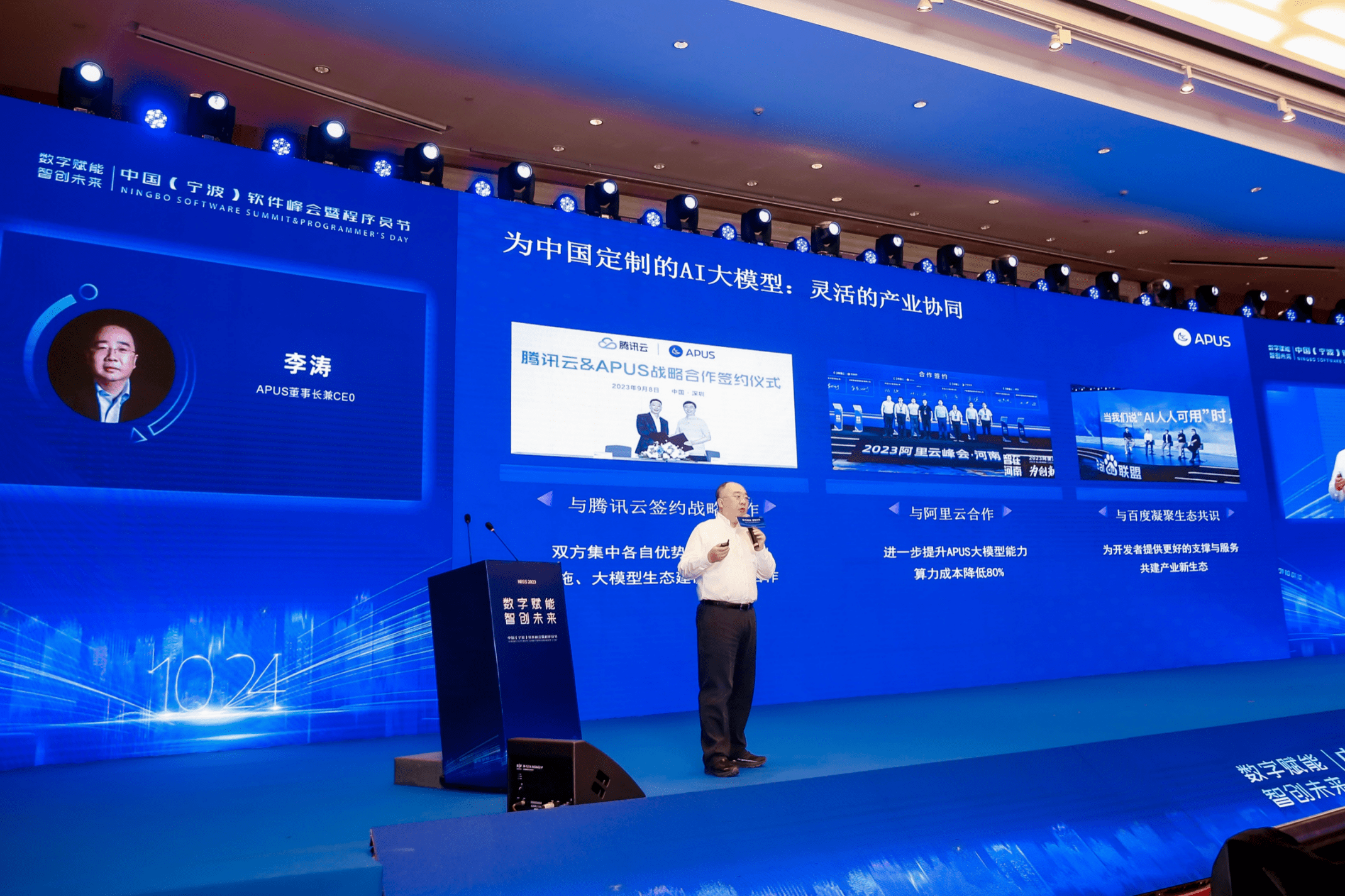
(APUS builds flexible industrial collaboration)
"Building China's big model" is a long-term correct thing. APUS is also adhering to this original intention to continue to consolidate platform capabilities and train large models to reason and evolve towards higher levels. Li Tao said: "We expect that APUS large models can play a fundamental role in thousands of industries; we also expect more developers to join the APUS ecosystem and use large models to create more viable AI applications."
With the theme of "Digital Empowerment, Intelligent Future Creation", this conference focuses on hot topics such as domestic open source ecology, AI large models, and industrial software empowerment. The activities include academician reports, release ceremonies, special reports, signing ceremonies, celebrity reports, press conferences, final reports, etc. In addition to Ni Guangnan and Shen Changxiang, representatives from companies such as China Unicom Cloud, Kingdee Cloud, and Tiger Industrial Cloud Group were invited to deliver the "voice of technology."
The above is the detailed content of APUS Li Tao: Customize large models for China to let AI create more value. For more information, please follow other related articles on the PHP Chinese website!

Hot AI Tools

Undresser.AI Undress
AI-powered app for creating realistic nude photos

AI Clothes Remover
Online AI tool for removing clothes from photos.

Undress AI Tool
Undress images for free

Clothoff.io
AI clothes remover

Video Face Swap
Swap faces in any video effortlessly with our completely free AI face swap tool!

Hot Article

Hot Tools

Notepad++7.3.1
Easy-to-use and free code editor

SublimeText3 Chinese version
Chinese version, very easy to use

Zend Studio 13.0.1
Powerful PHP integrated development environment

Dreamweaver CS6
Visual web development tools

SublimeText3 Mac version
God-level code editing software (SublimeText3)

Hot Topics
 1392
1392
 52
52
 Big model app Tencent Yuanbao is online! Hunyuan is upgraded to create an all-round AI assistant that can be carried anywhere
Jun 09, 2024 pm 10:38 PM
Big model app Tencent Yuanbao is online! Hunyuan is upgraded to create an all-round AI assistant that can be carried anywhere
Jun 09, 2024 pm 10:38 PM
On May 30, Tencent announced a comprehensive upgrade of its Hunyuan model. The App "Tencent Yuanbao" based on the Hunyuan model was officially launched and can be downloaded from Apple and Android app stores. Compared with the Hunyuan applet version in the previous testing stage, Tencent Yuanbao provides core capabilities such as AI search, AI summary, and AI writing for work efficiency scenarios; for daily life scenarios, Yuanbao's gameplay is also richer and provides multiple features. AI application, and new gameplay methods such as creating personal agents are added. "Tencent does not strive to be the first to make large models." Liu Yuhong, vice president of Tencent Cloud and head of Tencent Hunyuan large model, said: "In the past year, we continued to promote the capabilities of Tencent Hunyuan large model. In the rich and massive Polish technology in business scenarios while gaining insights into users’ real needs
 Bytedance Beanbao large model released, Volcano Engine full-stack AI service helps enterprises intelligently transform
Jun 05, 2024 pm 07:59 PM
Bytedance Beanbao large model released, Volcano Engine full-stack AI service helps enterprises intelligently transform
Jun 05, 2024 pm 07:59 PM
Tan Dai, President of Volcano Engine, said that companies that want to implement large models well face three key challenges: model effectiveness, inference costs, and implementation difficulty: they must have good basic large models as support to solve complex problems, and they must also have low-cost inference. Services allow large models to be widely used, and more tools, platforms and applications are needed to help companies implement scenarios. ——Tan Dai, President of Huoshan Engine 01. The large bean bag model makes its debut and is heavily used. Polishing the model effect is the most critical challenge for the implementation of AI. Tan Dai pointed out that only through extensive use can a good model be polished. Currently, the Doubao model processes 120 billion tokens of text and generates 30 million images every day. In order to help enterprises implement large-scale model scenarios, the beanbao large-scale model independently developed by ByteDance will be launched through the volcano
 Using Shengteng AI technology, the Qinling·Qinchuan transportation model helps Xi'an build a smart transportation innovation center
Oct 15, 2023 am 08:17 AM
Using Shengteng AI technology, the Qinling·Qinchuan transportation model helps Xi'an build a smart transportation innovation center
Oct 15, 2023 am 08:17 AM
"High complexity, high fragmentation, and cross-domain" have always been the primary pain points on the road to digital and intelligent upgrading of the transportation industry. Recently, the "Qinling·Qinchuan Traffic Model" with a parameter scale of 100 billion, jointly built by China Vision, Xi'an Yanta District Government, and Xi'an Future Artificial Intelligence Computing Center, is oriented to the field of smart transportation and provides services to Xi'an and its surrounding areas. The region will create a fulcrum for smart transportation innovation. The "Qinling·Qinchuan Traffic Model" combines Xi'an's massive local traffic ecological data in open scenarios, the original advanced algorithm self-developed by China Science Vision, and the powerful computing power of Shengteng AI of Xi'an Future Artificial Intelligence Computing Center to provide road network monitoring, Smart transportation scenarios such as emergency command, maintenance management, and public travel bring about digital and intelligent changes. Traffic management has different characteristics in different cities, and the traffic on different roads
 Uncovering the NVIDIA large model inference framework: TensorRT-LLM
Feb 01, 2024 pm 05:24 PM
Uncovering the NVIDIA large model inference framework: TensorRT-LLM
Feb 01, 2024 pm 05:24 PM
1. Product positioning of TensorRT-LLM TensorRT-LLM is a scalable inference solution developed by NVIDIA for large language models (LLM). It builds, compiles and executes calculation graphs based on the TensorRT deep learning compilation framework, and draws on the efficient Kernels implementation in FastTransformer. In addition, it utilizes NCCL for communication between devices. Developers can customize operators to meet specific needs based on technology development and demand differences, such as developing customized GEMM based on cutlass. TensorRT-LLM is NVIDIA's official inference solution, committed to providing high performance and continuously improving its practicality. TensorRT-LL
 Benchmark GPT-4! China Mobile's Jiutian large model passed dual registration
Apr 04, 2024 am 09:31 AM
Benchmark GPT-4! China Mobile's Jiutian large model passed dual registration
Apr 04, 2024 am 09:31 AM
According to news on April 4, the Cyberspace Administration of China recently released a list of registered large models, and China Mobile’s “Jiutian Natural Language Interaction Large Model” was included in it, marking that China Mobile’s Jiutian AI large model can officially provide generative artificial intelligence services to the outside world. . China Mobile stated that this is the first large-scale model developed by a central enterprise to have passed both the national "Generative Artificial Intelligence Service Registration" and the "Domestic Deep Synthetic Service Algorithm Registration" dual registrations. According to reports, Jiutian’s natural language interaction large model has the characteristics of enhanced industry capabilities, security and credibility, and supports full-stack localization. It has formed various parameter versions such as 9 billion, 13.9 billion, 57 billion, and 100 billion, and can be flexibly deployed in Cloud, edge and end are different situations
 Advanced practice of industrial knowledge graph
Jun 13, 2024 am 11:59 AM
Advanced practice of industrial knowledge graph
Jun 13, 2024 am 11:59 AM
1. Background Introduction First, let’s introduce the development history of Yunwen Technology. Yunwen Technology Company...2023 is the period when large models are prevalent. Many companies believe that the importance of graphs has been greatly reduced after large models, and the preset information systems studied previously are no longer important. However, with the promotion of RAG and the prevalence of data governance, we have found that more efficient data governance and high-quality data are important prerequisites for improving the effectiveness of privatized large models. Therefore, more and more companies are beginning to pay attention to knowledge construction related content. This also promotes the construction and processing of knowledge to a higher level, where there are many techniques and methods that can be explored. It can be seen that the emergence of a new technology does not necessarily defeat all old technologies. It is also possible that the new technology and the old technology will be integrated with each other.
 New test benchmark released, the most powerful open source Llama 3 is embarrassed
Apr 23, 2024 pm 12:13 PM
New test benchmark released, the most powerful open source Llama 3 is embarrassed
Apr 23, 2024 pm 12:13 PM
If the test questions are too simple, both top students and poor students can get 90 points, and the gap cannot be widened... With the release of stronger models such as Claude3, Llama3 and even GPT-5 later, the industry is in urgent need of a more difficult and differentiated model Benchmarks. LMSYS, the organization behind the large model arena, launched the next generation benchmark, Arena-Hard, which attracted widespread attention. There is also the latest reference for the strength of the two fine-tuned versions of Llama3 instructions. Compared with MTBench, which had similar scores before, the Arena-Hard discrimination increased from 22.6% to 87.4%, which is stronger and weaker at a glance. Arena-Hard is built using real-time human data from the arena and has a consistency rate of 89.1% with human preferences.
 GPT Store can't even open its doors. How dare this domestic platform take this path? ?
Apr 19, 2024 pm 09:30 PM
GPT Store can't even open its doors. How dare this domestic platform take this path? ?
Apr 19, 2024 pm 09:30 PM
Pay attention, this man has connected more than 1,000 large models, allowing you to plug in and switch seamlessly. Recently, a visual AI workflow has been launched: giving you an intuitive drag-and-drop interface, you can drag, pull, and drag to arrange your own workflow on an infinite canvas. As the saying goes, war costs speed, and Qubit heard that within 48 hours of this AIWorkflow going online, users had already configured personal workflows with more than 100 nodes. Without further ado, what I want to talk about today is Dify, an LLMOps company, and its CEO Zhang Luyu. Zhang Luyu is also the founder of Dify. Before joining the business, he had 11 years of experience in the Internet industry. I am engaged in product design, understand project management, and have some unique insights into SaaS. Later he



